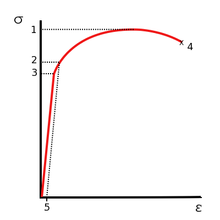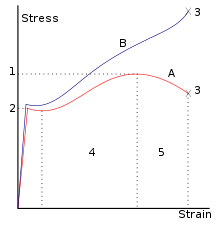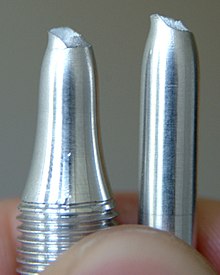Ultimate tensile strength
Ultimate tensile strength (UTS), often shortened to tensile strength (TS) or ultimate strength,[1][2] is the maximum stress that a material can withstand while being stretched or pulled before necking, which is when the specimen's cross-section starts to significantly contract. Tensile strength is the opposite of compressive strength and the values can be quite different.
The UTS is usually found by performing a tensile test and recording the stress versus strain; the highest point of the stress-strain curve is the UTS. It is an intensive property; therefore its value does not depend on the size of the test specimen. However, it is dependent on other factors, such as the preparation of the specimen, the presence or otherwise of surface defects, and the temperature of the test environment and material.
Tensile strengths are rarely used in the design of ductile members, but they are important in brittle members. They are tabulated for common materials such as alloys, composite materials, ceramics, plastics, and wood.
Tensile strength is defined as a stress, which is measured as force per unit area. For some non-homogeneous materials (or for assembled components) it can be reported just as a force or as a force per unit width. In the SI system, the unit is pascal (Pa) or, equivalently, newtons per square metre (N/m²). The customary unit is pounds-force per square inch (lbf/in² or psi), or kilo-pounds per square inch (ksi), which is equal to 1000 psi; kilo-pounds per square inch are commonly used for convenience when measuring tensile strengths.
Concept
Ductile materials

1. Ultimate strength
2. Yield strength
3. Proportional limit stress
4. Fracture
5. Offset strain (typically 0.2%)

1. Ultimate strength
2. Yield strength
3. Fracture
4. Strain hardening region
5. Necking region
A: Engineering stress
B: True stress
Many materials display linear elastic behavior, defined by a linear stress-strain relationship, as shown in the figure up to point 2, in which deformations are completely recoverable upon removal of the load; that is, a specimen loaded elastically in tension will elongate, but will return to its original shape and size when unloaded. Beyond this linear region, for ductile materials, such as steel, deformations are plastic. A plastically deformed specimen will not return to its original size and shape when unloaded. Note that there will be elastic recovery of a portion of the deformation. For many applications, plastic deformation is unacceptable, and is used as the design limitation.
After the yield point, ductile metals will undergo a period of strain hardening, in which the stress increases again with increasing strain, and they begin to neck, as the cross-sectional area of the specimen decreases due to plastic flow. In a sufficiently ductile material, when necking becomes substantial, it causes a reversal of the engineering stress-strain curve (curve A); this is because the engineering stress is calculated assuming the original cross-sectional area before necking. The reversal point is the maximum stress on the engineering stress-strain curve, and the engineering stress coordinate of this point is the tensile ultimate strength, given by point 1.
The UTS is not used in the design of ductile static members because design practices dictate the use of the yield stress. It is, however, used for quality control, because of the ease of testing. It is also used to roughly determine material types for unknown samples.[3]
Brittle materials
Brittle materials, such as concrete and carbon fiber, are characterized by failure at small strains. They often fail while still behaving in a linear elastic manner, and thus do not have a defined yield point. Because strains are low, there is negligible difference between the engineering stress and the true stress. Testing of several identical specimens will result in different failure stresses, this is due to the Weibull modulus of the brittle material.
The UTS is a common engineering parameter when design brittle members, because there is no yield point.[3]
Testing

Typically, the testing involves taking a small sample with a fixed cross-section area, and then pulling it with a controlled, gradually increasing force until the sample changes shape or breaks.
When testing metals, indentation hardness correlates linearly with tensile strength. This important relation permits economically important nondestructive testing of bulk metal deliveries with lightweight, even portable equipment, such as hand-held Rockwell hardness testers.[4]
It should be noted that while most metal forms, like sheet, bar, tube and wire can exhibit the test UTS, fibers, such as carbon fibers, being only 2/10,000th of an inch in diameter, must be made into composites to create useful real-world forms. As the datasheet on T1000G below indicates, while the UTS of the fiber is very high at 6,370MPa, the UTS of a derived composite is 3,040MPa - less than half the strength of the fiber.[5]
Typical tensile strengths
| Material | Yield strength (MPa) |
Ultimate strength (MPa) |
Density (g/cm³) |
|---|---|---|---|
| Structural steel ASTM A36 steel | 250 | 400 | 7.8 |
| Carbon steel 1090 | 250 | 841 | 7.58 |
| Human skin | 15 | ||
| Micro-Melt® 10 Tough Treated Tool Steel (AISI A11)[6] | 5171 | 5205 | 7.45 |
| 2800 Maraging Steel[7] | 2617 | 2693 | 8.00 |
| AerMet 340[8] | 2160 | 2430 | 7.86 |
| Sandvik Sanicro 36Mo logging cable Precision Wire[9] | 1758 | 2070 | 8.00 |
| AISI 4130 Steel, water quenched 855°C (1570°F), 480°C (900°F) temper[10] | 951 | 1110 | 7.85 |
| Titanium 11 (Ti-6Al-2Sn-1.5Zr-1Mo-0.35Bi-0.1Si), Aged[11] | 940 | 1040 | 4.50 |
| Steel, API 5L X65[12] | 448 | 531 | 7.8 |
| Steel, high strength alloy ASTM A514 | 690 | 760 | 7.8 |
| High density polyethylene (HDPE) | 26-33 | 37 | 0.95 |
| Polypropylene | 12-43 | 19.7-80 | 0.91 |
| Stainless steel AISI 302 - Cold-rolled | 520 | 860 | 8.19 |
| Cast iron 4.5% C, ASTM A-48 | 130 | 200 | |
| "Liquidmetal" alloy[citation needed] | 1723 | 550-1600 | 6.1 |
| Beryllium[13] 99.9% Be | 345 | 448 | 1.84 |
| Aluminium alloy[14] 2014-T6 | 414 | 483 | 2.8 |
| Aluminium alloy 6063-T6 | 248 | 2.63 | |
| Copper 99.9% Cu | 70 | 220 | 8.92 |
| Cupronickel 10% Ni, 1.6% Fe, 1% Mn, balance Cu | 130 | 350 | 8.94 |
| Brass | 200 + | 550 | 5.3 |
| Tungsten | 1510 | 19.25 | |
| Glass | 33[15] | 2.53 | |
| E-Glass | N/A | 1500 for laminates, 3450 for fibers alone |
2.57 |
| S-Glass | N/A | 4710 | 2.48 |
| Basalt fiber[16] | N/A | 4840 | 2.7 |
| Marble | N/A | 15 | |
| Concrete | N/A | 3 | 2.7 |
| Carbon fiber | N/A | 1600 for Laminate, 4137 for fiber alone |
1.75 |
| Carbon fiber (Toray T1000G)[17] | 6370 fibre alone | 1.80 | |
| Human hair | 380 | ||
| Bamboo | 350-500 | 0.4 | |
| Spider silk (See note below) | 1000 | 1.3 | |
| Darwin's bark spider silk[18] | 1652 | ||
| Silkworm silk | 500 | 1.3 | |
| Aramid (Kevlar or Twaron) | 3620 | 2757 | 1.44 |
| UHMWPE | 23 | 46 | 0.97 |
| UHMWPE fibers[19][20] (Dyneema or Spectra) | 2300-3500 | 0.97 | |
| Vectran | 2850-3340 | ||
| Polybenzoxazole (Zylon)[21] | 2700 | 1.56 | |
| Pine wood (parallel to grain) | 40 | ||
| Bone (limb) | 104-121 | 130 | 1.6 |
| Nylon, type 6/6 | 45 | 75 | 1.15 |
| Epoxy adhesive | - | 12 - 30[22] | - |
| Rubber | - | 15 | |
| Boron | N/A | 3100 | 2.46 |
| Silicon, monocrystalline (m-Si) | N/A | 7000 | 2.33 |
| Silicon carbide (SiC) | N/A | 3440 | |
| Ultra-pure silca glass fiber-optic strands[23] | 4100 | ||
| Sapphire (Al2O3) | N/A | 1900 | 3.9-4.1 |
| Boron Nitride Nanotube | N/A | 33000 | ? |
| Diamond | N/A | 2800 | 3.5 |
| Graphene | N/A | 130000[24] | 1.0 |
| First carbon nanotube ropes | ? | 3600 | 1.3 |
| Colossal carbon tube | N/A | 7000 | 0.116 |
| Carbon nanotube (see note below) | N/A | 11000-63000 | 0.037-1.34 |
| Carbon nanotube composites | N/A | 1200[25] | N/A |
- ^a Many of the values depend on manufacturing process and purity/composition.
- ^b Multiwalled carbon nanotubes have the highest tensile strength of any material yet measured, with labs producing them at a tensile strength of 63 GPa,[26] still well below their theoretical limit of 300 GPa[citation needed]. The first nanotube ropes (20mm in length) whose tensile strength was published (in 2000) had a strength of 3.6 GPa.[27] The density depends on the manufacturing method, and the lowest value is 0.037 or 0.55 (solid).[28]
- ^c The strength of spider silk is highly variable. It depends on many factors including kind of silk (Every spider can produce several for sundry purposes.), species, age of silk, temperature, humidity, swiftness at which stress is applied during testing, length stress is applied, and way the silk is gathered (forced silking or natural spinning).[29] The value shown in the table, 1000 MPa, is roughly representative of the results from a few studies involving several different species of spider however specific results varied greatly.[30]
- ^d Human hair strength varies by ethnicity and chemical treatments.
| Element | Young's modulus (GPa) |
Offset or yield strength (MPa) |
Ultimate strength (MPa) |
|---|---|---|---|
| silicon | 107 | 5000–9000 | |
| tungsten | 411 | 550 | 550–620 |
| iron | 211 | 80–100 | 350 |
| titanium | 120 | 100–225 | 240–370 |
| copper | 130 | 33 | 210 |
| tantalum | 186 | 180 | 200 |
| tin | 47 | 9–14 | 15–200 |
| zinc (wrought) | 105 | 110–200 | |
| nickel | 170 | 14–35 | 140–195 |
| silver | 83 | 170 | |
| gold | 79 | 100 | |
| aluminium | 70 | 15–20 | 40-50 |
| lead | 16 | 12 |
See also
- Flexural strength
- Specific strength
- Strength of materials
- Tensile structure
- Toughness
- Ultimate failure
References
- ^ Degarmo, Black & Kohser 2003, p. 31
- ^ Smith & Hashemi 2006, p. 223
- ^ a b NDT-ed.org
- ^ E.J. Pavlina and C.J. Van Tyne, "Correlation of Yield Strength and Tensile Strength with Hardness for Steels", Journal of Materials Engineering and Performance, 17:6 (December 2008)
- ^ http://www.carbonfibertubeshop.com/tube%20properties.html
- ^ [1]
- ^ [2]
- ^ [3]
- ^ [4]
- ^ [5]
- ^ [6]
- ^ USStubular.com
- ^ Beryllium I-220H Grade 2
- ^ Aluminum 2014-T6
- ^ Material Properties Data: Soda-Lime Glass
- ^ "Basalt Continuous Fibers". Retrieved 2009-12-29.
{{cite web}}: External link in|archive url=|ref=harv(help); Unknown parameter|archive url=ignored (|archive-url=suggested) (help)CS1 maint: postscript (link) - ^ Toray Properties Document
- ^ I Agnarsson, M Kuntner, T A Blackledge, Bioprospecting Finds the Toughest Biological Material: Extraordinary Silk from a Giant Riverine Orb Spider
- ^ Tensile and creep properties of ultra high molecular weight PE fibres
- ^ Mechanical Properties Data
- ^ Zylon Properties Document
- ^ Uhu endfest 300 epoxy: Strength over setting temperature
- ^ Fols.org
- ^ Lee, C.; et al. (2008). "Measurement of the Elastic Properties and Intrinsic Strength of Monolayer Graphene". Science. 321 (5887): 385. Bibcode:2008Sci...321..385L. doi:10.1126/science.1157996. PMID 18635798.
{{cite journal}}: Explicit use of et al. in:|author=(help); Invalid|ref=harv(help); Unknown parameter|laysummary=ignored (help) - ^ IOP.org Z. Wang, P. Ciselli and T. Peijs, Nanotechnology 18, 455709, 2007.
- ^ Yu, Min-Feng; Lourie, O; Dyer, MJ; Moloni, K; Kelly, TF; Ruoff, RS (2000). "Strength and Breaking Mechanism of Multiwalled Carbon Nanotubes Under Tensile Load". Science. 287 (5453): 637–640. Bibcode:2000Sci...287..637Y. doi:10.1126/science.287.5453.637. PMID 10649994.
{{cite journal}}: Invalid|ref=harv(help) - ^ F. Li, H. M. Cheng, S. Bai, G. Su, and M. S. Dresselhaus, "Tensile strength of single-walled carbon nanotubes directly measured from their macroscopic ropes". DOI:10.1063/1.1324984
- ^ K.Hata. "From Highly Efficient Impurity-Free CNT Synthesis to DWNT forests, CNTsolids and Super-Capacitors" (PDF).
- ^ Elices; et al. "Finding Inspiration in Argiope Trifasciata Spider Silk Fibers". JOM. Retrieved 2009-01-23.
{{cite web}}: Explicit use of et al. in:|last=(help) - ^ Blackledge; et al. "Quasistatic and continuous dynamic characterization of the mechanical properties of silk from the cobweb of the black widow spider Latrodectus hesperus". The Company of Biologists. Retrieved 2009-01-23.
{{cite web}}: Explicit use of et al. in:|last=(help) - ^ A.M. Howatson, P.G. Lund, and J.D. Todd, Engineering Tables and Data, p. 41
Further reading
- Giancoli, Douglas, Physics for Scientists & Engineers Third Edition (2000). Upper Saddle River: Prentice Hall.
- Köhler, T.; Vollrath, F. (1995). "Thread biomechanics in the two orb-weaving spiders Araneus diadematus (Araneae, Araneidae) and Uloboris walckenaerius (Araneae, Uloboridae)". Journal of Experimental Zoology. 271: 1–17. doi:10.1002/jez.1402710102.
{{cite journal}}: Cite has empty unknown parameter:|author-name-separator=(help); Invalid|ref=harv(help); Unknown parameter|author-separator=ignored (help) - T Follett, Life without metals
- Min-Feng, Yu; Lourie, O; Dyer, MJ; Moloni, K; Kelly, TF; Ruoff, RS (2000). "Strength and Breaking Mechanism of Multiwalled Carbon Nanotubes Under Tensile Load". Science. 287 (5453): 637–640. Bibcode:2000Sci...287..637Y. doi:10.1126/science.287.5453.637. PMID 10649994.
{{cite journal}}: Cite has empty unknown parameter:|author-name-separator=(help); Invalid|ref=harv(help); Unknown parameter|author-separator=ignored (help) - George E. Dieter, Mechanical Metallurgy (1988). McGraw-Hill, UK
